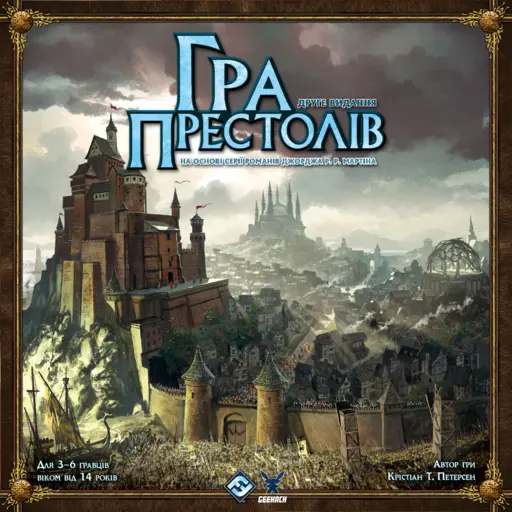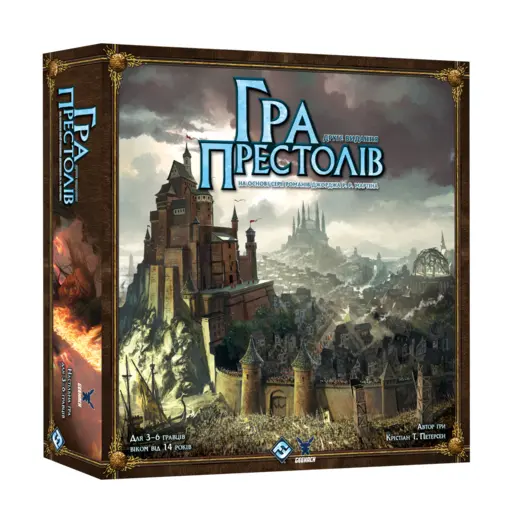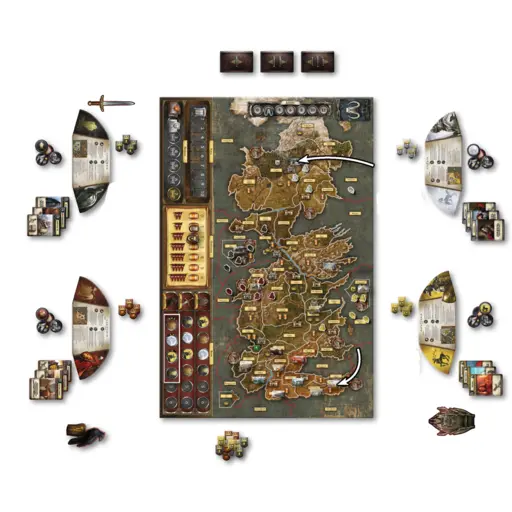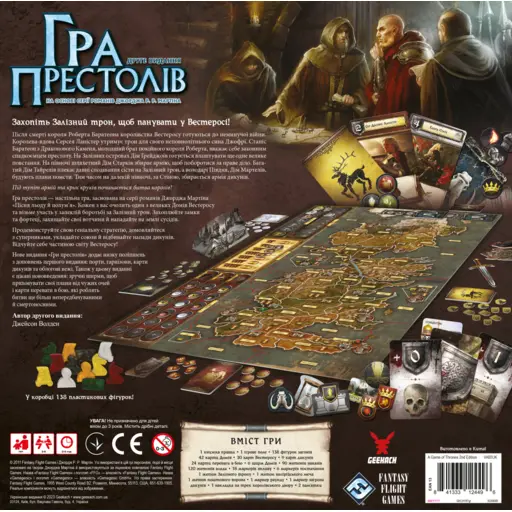Board Game A Game of Thrones. Second Edition
The most successful tabletop incarnation of George R.R. Martin`s cult epic about the struggle of the great Houses for the Iron Throne.
AN OLD SONG ABOUT THE MAIN
The participants of the game are invited to sing the "Song of Ice and Fire" anew. All the main characters are still alive, cheerful and full of strength. King Robert Baratheon is dead, long live the new king! Who will become him? Who will rule the Seven Kingdoms? The noble Starks, the treacherous Lannisters, the slippery Greyjoys, the ambitious Tyrells, the cruel Martells or the powerful Baratheons? Leading these great Houses, the players will try to capture as many lands with castles and fortresses as possible in ten rounds. The winner will take their rightful place on the Iron Throne.
GAME OVERVIEW
The board game "Game of Thrones" is a grand strategy game with diplomacy and territory control mechanics. Each game round consists of three phases. In the Westeros phase, the top cards in the three Westeros decks are revealed and their effects are activated. In this phase, the marker on the round track and the threat marker on the wildling track are also moved. The wildling attack occurs when the marker reaches 12. Players must work together to repel the attack, otherwise trouble awaits them.
In the planning phase, players place orders face down on the board, and in the action phase, they play these orders. The game ends after the tenth round. Or earlier, if one of the Houses controls seven lands with castles and fortresses - such a player immediately wins.
WESTEROS CARDS
The Westeros card & Players place bets by clenching power tokens in their fists, and the winners place their tokens on the first divisions of the Iron Throne, Fiefdoms, and Royal Court tracks and receive the corresponding domination tokens - the Iron Throne, the Valyrian Sword, and the Post Raven.
PLANNING PHASE
In this phase, players place orders face down on the board. Orders can be regular or special. The maximum number of special orders a player can give is determined by the Royal Court track. When players are finished, the order tokens are flipped over. The owner of the Post Raven token can replace one of his orders or look at the top card from the wildling deck. There are five types of orders: campaign, defense, support, raid, and power reinforcement.
ACTION PHASE
The action phase is divided into four stages. First, players take turns executing raid orders – removing adjacent enemy orders. By removing the power reinforcement order, the player receives an additional power token, while depriving the opponent of his power token.
During the campaign phase, players take turns maneuvering – moving units to adjacent territories, all together or partially. You can only have a conflict in one territory per turn. When opposing units meet, a battle begins immediately. During the Power Gain phase, players execute these orders and receive power tokens from the supply.
BATTLE
When opposing units meet in the same territory, a battle begins. Players are allowed to call for support by playing such an order on adjacent territories. In this case, auxiliary units remain in their places, but their strength is taken into account in the battle. Then the opposing sides add up their strength. Soldiers give one strength point each, knights give two, ships give one, and a siege tower gives as many as 4 if attacking a fortress or castle.
The attacker adds value to the campaign order, and the defender adds value to the defense order and garrison tokens. After that, players play one House card each, add their strength and apply effects. The Valyrian sword increases the total strength by one unit. The strongest player wins the battle. The loser loses as many units as there were swords on the winner`s House card, and then retreats, moving the surviving units to an adjacent territory.
Publisher: Geekach
Language: Ukrainian
Players: 3-6
Play time: 120-180 m
Age: 13+
- Rulebook
- Playing field
- 138 unit figures (6 different colors):
- 60 soldiers (10 from each of the 6 Houses)
- 30 knights (5 from each of the 6 Houses)
- 36 ships (6 from each of the 6 Houses)
- 12 siege towers (2 from each of the 6 Houses) - 105 cards:
- 42 House cards (7 from each of the 6 Houses)
- 30 Westeros cards
- 9 wildling cards
- 24 combat advantage cards - 2 landmarks
- 6 House screens
- 266 tokens:
- 90 order tokens (from each of the 15 each of 6 Houses)
- 120 Power Tokens (20 each of 6 Houses)
- 18 Influence Tokens (3 each of 6 Houses)
- 6 Supply Tokens (1 each of 6 Houses)
- 14 Neutral Lord Tokens
- 6 Victory Tokens (1 each of 6 Houses)
- 6 Garrison Tokens (1 each of 6 Houses)
- 1 Iron Throne Token
- 1 Valyrian Sword Token
- 1 Post Raven Token
- 1 Round Token
- 1 Wildling Threat Token
- 1 Royal Court Track Overlay






